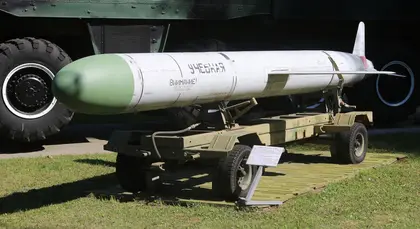Russia is bombarding Ukraine with missiles that it received from Kyiv in 1999 in a debt repayment agreement, a new report has claimed.
What was the agreement?
JOIN US ON TELEGRAM
Follow our coverage of the war on the @Kyivpost_official.
In 1999, the Cabinet of Ministers of Ukraine headed by Valeriy Pustovoitenko and the Russian government led by Vladimir Putin, signed an agreement in Yalta to settle the issue of a debt owed for Russian natural gas.
Kyiv owed Hr. 275 million (worth $7.45 million today) and agreed to transfer eight Tu-160 bombers, three Tu-95MS bombers, and 575 Kh-55 cruise missiles to Moscow to pay it off.
What has the new investigation found?
The Radio Free Europe investigation examined the text of the 1999 agreement and found the serial numbers of the missiles that were transferred.
They then compared them to the serial numbers found on fragments of missiles used in attacks on Ukraine.
The project discovered at least ten missiles from the list that had been launched at Ukrainian cities. Some were shot down by air defenses, but others hit residential buildings.
Three missiles shot down in January, May and April 2023 in the Kyiv region are on the list of missiles transferred to Moscow in 1999.
How much damage have these missiles caused?
It’s difficult to say exactly how much damage the missiles have done to Ukraine, but a Kyiv Post analysis found Russia launched 114 in the month of May alone, although 106 were intercepted and destroyed by air defenses.

$16 Million Worth of Shahed Parts Lost as Warehouse Burns Down - HUR
Tell me more about these missiles
The Kh-555 cruise missile was created as a non-nuclear version of its predecessor, the Kh-55 missile, developed in the 1970s and 1980s.
The Kh-55 was developed as a response to the American AGM-86 and copied the concept of air defense breakthrough with low-altitude flight and its own low observability to radar.
Although it shared similarities with its American counterpart, the Kh-55 could not surpass its competitor, especially in accuracy. While American cruise missiles have a proven accuracy of several meters, the Kh-55 could only manage up to 100 meters.
Eventually, the Kh-55SM modernized missile was developed with an increased range from 2,500 km to 3,500 km by installing additional conformal tanks on the sides of the missile.
The cruise missile’s flight range was made possible by the R95-300 engine from the then-Soviet-now-Ukrainian manufacturer Motor Sich.
The Kh-555 missile
In the 1990s, the Kh-555 missile was created based on the Kh-55SM. Unlike its predecessor, the Kh-555 had a conventional warhead and a modernized guidance system. The missile’s development continued until the mid-2000s.
One of the challenges was designing an effective high-explosive or cluster warhead. It turned out to be heavier than a nuclear munition.
The increase in weight and size led to a decrease in the missile’s range, which fell to around 2,000 km.
The second challenge was the missile’s guidance system. In addition to inertial navigation, a Tercom system with radio and optical channels, as well as satellite navigation, was added.
However, a significant part of the electronic “guts” remained on the technological base of the 1960s and 1970s, as indicated by the surviving blocks of downed cruise missiles.
The Raduga Design Bureau, the missile’s developer, does not publish the cruise missile’s declared characteristics regarding the warhead and flight range. Therefore, information regarding these specifications relies on different statements made at different times.
Length: 6.04 m
Wingspan: 3.1 m
Starting weight: 1,500 kg
Warhead weight: 200-410 kg
Flight range: 2,000-2,500 km
Speed: up to 830 km/h Kh-555
Carriers: Tu-95, Tu-160
Сan Ukraine’s air defense shoot down this missile?
Ukraine’s air defense faces a daunting challenge in intercepting the Kh-555 missile – it was specifically designed with a reduced radar cross-section, and it flies at high subsonic speeds (about the same as a cruising airliner) and extremely low altitudes (under 100 meters) while hugging the terrain.
While Western analysts say this should pose little problem for modern air defense systems like the Patriot and NASAMS, those systems are not protecting all areas of Ukraine. The older systems Ukraine may be employing to protect some locations may not have the same success rate as those recently provided, but limited number of Western weapons systems.
The missile aims to strike strategically important stationary ground targets with pre-determined coordinates.
Given the missile’s ability to fly to pre-planned coordinates, it is reasonable to assume that Russia is employing the Kh-555 as a tool of intimidation against the Ukrainian civilian populace.
You can also highlight the text and press Ctrl + Enter






